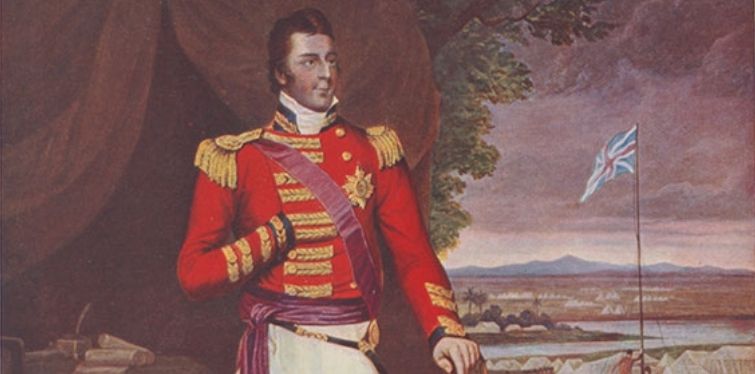Our good friend and collaborator Joshua Provan has authored a new book Bullocks, Grain and Good Madeira: The Maratha and Jat Campaigns, 1803-1806, detailing part of the British experience in India during the Napoleonic Wars. Josh has kindly allowed us to publish an extract from his book on our blog.
The Capture of Pune
The Second Maratha War was meant to be a simple affair to restore the Maratha Peshwa Bajirao II, who had fled his capital at Pune after his army was defeated by Yashwantrao Holkar, during the Maratha civil war, and enforce the treaty of Bassein, which would draw the Maratha Confederacy into the orbit of the East India Company. Major General Arthur Wellesley was selected to undertake the restoration of the Peshwa, which meant marching a small company army on Pune, potentially defeating Holkar and deposing Bajirao’s brother, the puppet Peshwa, Amrutrao. The operation undertaken by General Wellesley, while not encountering an enemy, demonstrates the difficulties presented by an Indian campaign in terms of logistics and terrain, and a certain audacity in the character of the future Duke of Wellington that is often overlooked.
After the capture of Pune and the restoration of Bajirao, the refusal of the Maratha confederates led by Daulatrao Sindhia to accept the treaty of Bassein saw the British commence general operations that would see the famous battles of Laswari and Assaye fought and the downfall of the Maratha state.
***
Wellesley’s detachment was to advance to secure Pune ahead of the main army under Lieutenant General Stuart. Governor General Wellesley approved the appointment on 4 April, by which time his younger brother had already come in sight of Pune. Major General Wellesley’s long-term planning might have included the possibility of a protracted campaign but he thought that the wars of expansion were becoming destabilising. He wrote shortly before hostilities broke out that, ‘I am in general inclined to decide that we have enough; or as much, at least, if not more than we can defend.’ In terms of his goal to restore the Peshwa, in February he wrote that he would give it up entirely if he found the people opposed to such a measure.

Major General Arthur Wellesley by Robert Home (1804)
Shortly after his arrival at Hurryhoor, Wellesley received his written orders to secure the loyalty of the southern Jagirdars, [landholders] declare the restoration of the Peshwa and join with the Hyderabad subsidiary army under Colonel Stevenson at Miraj. Once the two contingents had joined, in total the combined force would number some 10,000 men. According to his dispatches Wellesley’s advance guard had crossed the Tombuddra by 12 March, where a few sepoys deserted during the night, which had not been unexpected. Wellesley’s knowledge of the Marathas was based on the actions of Dhundiah Waugh, who he had defeated in 1800, and his reading of traditional Maratha tactics, which though valid regarding Waugh, were misleading when it came to [Daulutrao] Sindhia. Because the enemy had a preponderance of cavalry, he assumed they would lunge for his supplies, and so he anticipated that the height of the swollen rivers would impede their freedom of movement, whereas with his basket boats and, if he could get them, pontoons, he could move freely. The biggest challenge would be water and forage, but he hoped his precautions would offset any trouble caused by the rains.
When it was brigaded, the bulk of Wellesley’s advanced detachment was made up of battalions of sepoys, amongst which were the 3rd Madras Native Infantry, whose British quartermaster was Captain James Welsh who left an account of the campaign. However, the core of it was made up of three King’s Regiments. The newest was the 78th Regiment of Foot (Ross-Shire Buffs). It had been raised in 1793 and arrived in India in 1797. Amongst the rank and file was a soldier named Roderick Innes, who, later in life, unusually, left a memoir. His thick natural inflection when recounting Indian names and places was marked and he retained a morbid sense of humour into his later years, especially towards anything relating to the torture of animals for sport. In comparison to the ‘Buffs’, the 74th (Highland) Regiment of Foot made most others look like raw recruits. They had been formed in 1787 and had been in India since 1789. Their roll of honour reflected their long service. A detachment of the 74th had the honour of firing the feu de joie upon the hoisting of the new pattern union flag at Bombay in spring of 1801. The 19th Light Dragoons had by this time also spent the majority of its existence on active service. Indeed, it had been raised specifically for service in India, beginning life as the 23rd Light Dragoons in 1781, raised by an identically named cousin of Sir John Burgoyne, who had surrendered to the Americans at Saratoga in 1777. Up until that point the company’s forces had been chronically short of regular cavalry and the ‘23rd’ had been the answer, raised from drafts of other cavalry regiments. When they landed at Madras in late October of 1782 and became the first King’s regiment of cavalry to arrive in India. In 1786 the number of the regiment was changed to 19. Responsible for the technical aspect of the campaign were the Engineers, chief of whom was Captain Johnson, ably supported by Lieutenant John Blakiston, who helpfully left a memoir of the campaign and thought himself an unlettered dunce, whose shoulders had been sufficiently broad, and his head of sufficient thickness, to pursue a military career.
On 15 April, Wellesley had already heard indications that Holkar was retreating. Wellesley and Stevenson were close to Akloos, but remained separate. A conference was held in which separate operations were agreed on, and another report arrived which told that Holkar was moving to Chandore. This was confirmed in the following days.
The countryside bordered on being barren from the constant deprivations of previous years, no seed had been sown and while every town was fortified with high, towered, mud walls to prevent surprise attacks, most of the population seemed to have become refugees or gone into hiding. Blakiston even mentions, though he may have been confusing the chronology, that the army was forced at times to take thatch from houses in order to procure forage.
Every few days the same issues appeared in Wellesley’s correspondence; reports of the submission of jaghirdars, the anxious need for boats to be stockpiled at the rivers. The health of the bazaar and the necessity of making the Fort at Darwar neutral. He was also hopeful that the Peshwa would make some sort of diplomatic overture to Holkar, so as to keep Colonel Stevenson safe. However, the Peshwa would not entertain such an idea.

Bajirao II Peshwa
On 31 March they made camp on the north bank of the Kistna, where the army: ‘halted for two days, in order to establish at this place a field hospital, which is much wanted on account of the general deficiency among the native corps of carriage for their sick.’ Wellesley’s tallies of suppliers reveal that he had 10,000 brinjarry bullocks with full bags in attendance, of which the bazaars went through 200 every day. He calculated he had enough to last 50 days. At this stage he was in a sort of self – satisfied wonder at the ability of Mysore to supply him with all his wants.
As of early April, seven southern jaghirdars had joined Wellesley with 6,350 cavalry and 2,800 infantry. Wellesley was careful to make them welcome, Blakiston remembered: ‘On our part, these chiefs were received with military honours, having a salute of artillery fired for them, according to their rank.’ Two weeks later Wellesley wrote to Major Kirkpatrick that those who had joined were principally leaders who had served with him against Dundiah Waugh in 1800, or knew him because of it. Amongst those who showed up was Bapu Gokhla whose 2,000 Maratha cavalry would prove an invaluable asset.
General orders issued to every department and battalion warned that Maratha territory was to be considered friendly and looters would be flogged or hanged. That went for looters in the local area unattached to the army as well.
On 7 April Wellesley reported with satisfaction that, ‘I am in good marching trim; and if I can keep my cattle alive, I do not fear any confederacy that can be formed, after I shall once reach Poonah.’

View of Pune in the late 18th century
This last sentiment spoke to the uncertainty about what would happen after the Peshwa was restored to Pune, though the southern jaghirdars seemed in favour of Bajirao, the great lords then in the field with their armies were politically unpredictable and, in reality, both Holkar and Sindhia were aghast at having to abide by the Treaty of Bassein.
Advanced scouts had come in sight of Pune on 8 April and the end of the beginning seemed in sight. At ‘Kawlaspoor’ on 11 April Wellesley wrote a memorandum on the subject of Bridges and boats. It anticipated the need for a pontoon train and a stockpile of boats for operations towards the Narbudda.
On 17 April from a place called Samergaum Wellesley wrote to Amrutrao, the Peshwa’s brother and Holkar’s puppet. Intelligence from Colonel Collins dated 25 March indicated that there was a real concern that the puppet Peshwa would burn Pune if the British seemed likely to take it. He wrote a letter to Amrutrao informing him of his approach and he would ‘keep up the correspondence till I get within reach of Poonah with the cavalry, when I shall move forward briskly to prevent the execution of this horrible plan.’ The British had been moving at the astonishing rate of 20 miles a day, and were encamped in the shade of Little Bhore Gat when this worrying intelligence arrived. There were waterfalls along the approach to the ghat, and the rank and file were struck by the impressiveness of the landscape. ‘The force of the water in falling was altogether beyond description, and when the sun was shining, the colour was various, and it looked most wonderful.’
The next day, intelligence arrived that Amrutrao had left Pune, but Wellesley doubted the report and assured Colonel Close that he would ‘march tomorrow night to Poonah with the cavalry.’ It was a tougher assignment than the men could have imagined, even those hardened from the relentless marching and drilling the general had instituted since January. They began to ascend the gat at around 6:00 a.m. on 19 April.
At 8:00 a.m., a wearied Wellesley was writing by the ‘road’ side expecting to be delayed for another hour or two and knowing the main body would not be able to move until the road had been cleared by the pioneers. ‘I shudder when I think of the dreadful destruction of the wheel carriages which there will be on this day’s and to-morrow’s march.’
The British commander rode into Pune at 3:00 a.m. on the 20th, the city was secured and Amrutrao was found to have fled. Wellesley went to Colonel Close’s house [Close was the former resident at Pune] and quartered his troops. For the rest of the force, climbing the ghat was a nightmare. As per Wellesley’s instructions any man not on duty laboured in the sticky, rising 120°F/48°C heat (inside an officer’s tent) alongside the pioneers to improve a track through the rock and trees but to little avail. Innes remembered that the guns had to be hauled up using a time consuming and laborious pulley system:
‘A strong advanced guard was ordered to take possession of the high ground; and next to drag up the guns. This was very hard labour, for as we could not drag them up behind us, we tied the one end of the rope to the guns, and passing the other round a tree, the men having hold of the rope, ran down the hill and by this means dragged the guns up. But it was a very tedious process as the ropes had to be loosed and retied every rope’s length, and this with every gun. It took us two days hard labour before we had them safely landed at the top of the hill;’
After this, they tried to bring up the supplies but many of the tumbrils were old and the wheels and axles in a dire state, according to Wellesley, resulting in the loss of many animals and supplies. It took three days before the last of the army got over...

Bullocks, Grain and Good Madeira: The Maratha and Jat Campaigns, 1803-1806, by Joshua Provan is available from Helion & Co. and from all good booksellers.



Share and get 15% off!
Simply share this product on one of the following social networks and you will unlock 15% off!